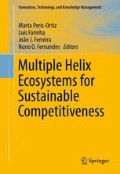Abstract
The Triple Helix (TH) model is an analysis framework in which universities act as key drivers of regional innovation development in knowledge-based societies. The TH model describes interactions between three actors—university, industry, and government. Most empirical studies have addressed the role of universities, choosing to adopt a macro perspective rather than a firm perspective. Thanks to the TH model’s theoretical potential, studies using the TH framework have greatly contributed to our understanding of the dynamics and interactions among these actors. Nevertheless, this framework still contains gaps such as determining the value and practical implications of the role of firms in the TH model. This research challenges the TH literature’s traditional emphasis on the university as the main driver of innovation by addressing the following research question: Is the university really the main driver of innovation, or does each of the three helices play this role at some stage of the innovation process? Hence, this study examines the applicability and practical value of the TH model when exploring business creation, business growth, and firms’ contribution to regional innovation development. The study also explores firms’ interactions with universities and governments at the European, national, and regional levels. Specifically, this exploratory study examines the case of Abengoa, a multinational leader in renewable energy industry, specializing in innovative, sustainable biotechnology and biochemistry solutions.
Access this chapter
Tax calculation will be finalised at checkout
Purchases are for personal use only
Notes
- 1.
- 2.
The service sector represents 62.0 % of Andalusia’s GDP. The construction sector (10.8 %), manufacturing (9.0 %), agriculture, farming, and fisheries (6.1 %), and energy (2.4 %) are the four next biggest industries in Andalusia in terms of GDP (INE, Regional accounts, 2007)
References
Arbuthnott A, von Friedrichs Y (2013) Entrepreneurial renewal in a peripheral region: the case of a winter automotive-testing cluster in Sweden. Entrep Reg Dev 25(5–6):371–403
Asheim BT, Lawton SH, Oughton C (2011) Regional innovation systems: theory, empirics and policy. Reg Stud 45(7):875–891
Bramwell A, Wolfe DA (2008) Universities and regional economic development: the entrepreneurial University of Waterloo. Res Policy 37(8):1175–1187
Brännback M, Carsrud A, Krueger N Jr, Elfving J (2008) Challenging the Triple Helix model of regional innovation systems: a venture-centric model. Int J Technoentrep 1(3):257–277
Etzkowitz H (1994) Academic-industry relations: a sociological paradigm for economic development. In: Leydesdorff H, Van den Besselaar P (eds) Evolutionary economics and chaos theory: new directions in technology studies. Pinter, Londres
Etzkowitz H (2003) Innovation in innovation: the Triple Helix of university- industry-government relations. Soc Sci Inf 42(3):293–337
Etzkowitz H (2008) The Triple Helix: university–industry–government innovation in action. Routledge, New York
Etzkowitz H, Leydesdorff L (1998) The endless transition: a “triple helix” of university-industry-government relations. Minerva 36(3):203–208
Etzkowitz H, Leydesdorff L (2000) The dynamics of innovation: from national systems and “mode 2” to a triple helix of university-industry-government relations. Res Policy 29(2):109–123
Etzkowitz H, Ranga M, Dzisah J (2012) Wither the university? The Novum Trivium and the transition from industrial to knowledge society. Soc Sci Inf 51(2):143–164
Fiore A, Grisorio MJ, Prota F (2011) Regional innovation systems: which role for public policies and innovation agencies? Some insights from the experience of an Italian region. Eur Plann Stud 19(8):1399–1422
García-Aracil A, de Lucio IF (2008) Industry-university interactions in a peripheral European region: an empirical study of Valencian firms. Reg Stud 42(2):215–227
González de la Fe T (2009) El modelo de Triple Hélice de relaciones universidad, industria y gobierno: un análisis crítico. Arbor 185(738):739–755
Klitkou A, Coenen L (2013) The emergence of the Norwegian solar photovoltaic industry in a regional perspective. Eur Plann Stud 21(11):1796–1819
Leydesdorff L, Meyer M (2006) Triple helix indicators of knowledge-based innovation systems—introduction to the special issue. Res Policy 35(10):1441–1449
Leydesdorff L, Etzkowitz H (2003) Can “the public” be considered as a fourth helix in university–industry–government relations? Report of the fourth Triple Helix conference. Sci Publ Policy 30(1):55–6
Molas-Gallart J, Salter A, Patel P, Scott A, Duran X (2002) Measuring third stream activities. Final report to the Russell Group of Universities. Science and Technology Policy Research (SPRU), University of Sussex, Birmingham
Parayil P (2003) Mapping technological trajectories of the green revolution and the gene revolution from modernization to globalization. Res Policy 32(6):971–990
Porter ME (1990) The competitive advantage of nations. Macmillan, London
Ranga L, Miedema J, Jorna R (2008) Enhancing the innovative capacity of small firms through triple helix interactions: challenges and opportunities. Technol Anal Strateg Manage 20(6):697–716
Ranga M, Etzkowitz H (2010) Creative reconstruction: a triple helix-based innovation strategy in central and Eastern Europe countries’. In: Saad M, Zawdie G (eds) Theory and practice of Triple Helix model in developing countries: issues and challenges. Routledge, New York
Ranga M (2011) University–industry–government interactions in the knowledge society: From ‘spheres’ to ‘spaces’. International Institute Casa de Mateus. Available at: www.iicm.pt/Encontro2011/M_Ranga_Presentation_Portugal.ppt
Sábato J (1975) El pensamiento latinoamericano en la problemática ciencia– tecnología-desarrollo-dependencia. Paidós, Buenos Aires
Steiber A, Alänge S (2013) The formation and growth of Google: a firm-level triple helix perspective. Soc Sci Inf 52(4):575–604
Symon G, Cassell C (eds) (2012) Qualitative organizational research: core methods and current challenges. Sage, London
Yin RK (1994) Case study research: design and methods. Sage, Thousand Oaks
Author information
Authors and Affiliations
Corresponding author
Editor information
Editors and Affiliations
Appendix
Appendix
Rights and permissions
Copyright information
© 2016 Springer International Publishing Switzerland
About this chapter
Cite this chapter
Merchán-Hernández, C., Leal-Rodríguez, A.L. (2016). Revisiting the Triple Helix Innovation Framework: The Case of Abengoa. In: Peris-Ortiz, M., Ferreira, J., Farinha, L., Fernandes, N. (eds) Multiple Helix Ecosystems for Sustainable Competitiveness. Innovation, Technology, and Knowledge Management. Springer, Cham. https://doi.org/10.1007/978-3-319-29677-7_4
Download citation
DOI: https://doi.org/10.1007/978-3-319-29677-7_4
Published:
Publisher Name: Springer, Cham
Print ISBN: 978-3-319-29675-3
Online ISBN: 978-3-319-29677-7
eBook Packages: Business and ManagementBusiness and Management (R0)

